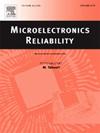Effects of humidity, ionic contaminations and temperature on the degradation of silicone-based sealing materials used in microelectronics
IF 1.6
4区 工程技术
Q3 ENGINEERING, ELECTRICAL & ELECTRONIC
引用次数: 0
Abstract
This paper investigates the effects of three ageing factors (chemical, humidity, and temperature) and their interactions on the physical properties and degradation of silicone sealant used in microelectronic applications. The thermal degradation of silicone sealants was investigated by exposing samples to temperatures in the range of 150 up to 175 °C. Also, a set of samples were aged at 40 °C in a salt spray set-up with 100 % humidity in a salty atmosphere. Results showed detectable changes in the FTIR spectra of aged specimen as compared with the as-received sample. In all accelerated testing conditions, peak intensities decreased with ageing time, inferring that that the surface characteristics of the sealant is affected by ageing. Shear test results showed that with increasing the ageing time, the maximum shear stress in most cases has decreased in all ageing conditions. Also, it appears that samples with longer ageing times have experienced more elongation before failure. Results also show that salt spraying of specimens is associated with a decrease in the mechanical properties of the sealant, indicating the deleterious implications of ionic contaminations for the mechanical properties of samples.
湿度、离子污染和温度对微电子学中使用的硅基密封材料降解的影响
本文研究了三种老化因素(化学、湿度和温度)及其相互作用对微电子应用中所用硅酮密封胶的物理性质和降解的影响。通过将样品暴露在 150 至 175 °C 的温度范围内,研究了硅酮密封胶的热降解。此外,一组样品还在 40 °C、湿度为 100 % 的盐雾环境中进行了老化试验。结果显示,与收到的样品相比,老化样品的傅立叶变换红外光谱发生了可检测到的变化。在所有加速测试条件下,峰值强度都随着老化时间的延长而降低,这表明密封胶的表面特性受到了老化的影响。剪切试验结果表明,随着老化时间的延长,在所有老化条件下,大多数情况下的最大剪切应力都有所下降。此外,老化时间较长的样品似乎在失效前经历了更大的伸长率。结果还显示,对试样进行盐雾处理会降低密封胶的机械性能,这表明离子污染会对试样的机械性能产生有害影响。
本文章由计算机程序翻译,如有差异,请以英文原文为准。
求助全文
约1分钟内获得全文
求助全文
来源期刊

Microelectronics Reliability
工程技术-工程:电子与电气
CiteScore
3.30
自引率
12.50%
发文量
342
审稿时长
68 days
期刊介绍:
Microelectronics Reliability, is dedicated to disseminating the latest research results and related information on the reliability of microelectronic devices, circuits and systems, from materials, process and manufacturing, to design, testing and operation. The coverage of the journal includes the following topics: measurement, understanding and analysis; evaluation and prediction; modelling and simulation; methodologies and mitigation. Papers which combine reliability with other important areas of microelectronics engineering, such as design, fabrication, integration, testing, and field operation will also be welcome, and practical papers reporting case studies in the field and specific application domains are particularly encouraged.
Most accepted papers will be published as Research Papers, describing significant advances and completed work. Papers reviewing important developing topics of general interest may be accepted for publication as Review Papers. Urgent communications of a more preliminary nature and short reports on completed practical work of current interest may be considered for publication as Research Notes. All contributions are subject to peer review by leading experts in the field.
 求助内容:
求助内容: 应助结果提醒方式:
应助结果提醒方式:


